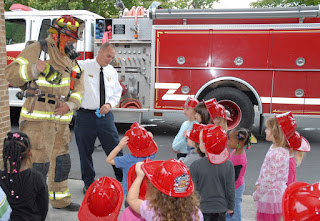Health of Child :Child care programs, preschools, and schools are obliged
to have consistent fire exit drills. Over and over again, however, these drills
are trained evacuations with insufficient information or training given on how
to respond to a true fire emergency. Such as, many adults do not realize that
in a fire emergency, the facility can be totally engulfed in flames and smoke.
The air temperature can exceed 600 degrees Fahrenheit at adult head level,
making it difficult to walk out of the building, and dense, dark smoke can
eliminate visibility of emergency lighting or exit lights. In cases such as
these, the trained “line up and walk out promptly” exit plan rarely works.
How can you prepare children and staff for a real fire
emergency? The best preparation is to prevent a fire from happening. Most
structural fires can be prevented through staff awareness and thoughtfulness
regarding safety considerations. All staff, including managers, teachers, and maintenance
and food service experts, have important parts in maintaining a safe
environment.
Maintaining a Safe Environment
All programs, for example, ought to have normal and thorough
reviews of the facility. Your community fire marshal can identify and provide
suggestions to remove most dangers. Structural considerations such as approved
fire walls and doors, fear bars on doors, and two exits from each location can
prevent injury and death in case of emergency.
Local utility companies additionally perform reviews of
electrical, gas, and other utility equipment, and they can guarantee that all
equipment is properly installed and maintained. Structural fires are frequently
linked to faulty electrical equipment.
In addition to reviews, your local fire department can give
fire safety training for staff. All staff should be aware of potential dangers,
particularly in the area of the facility where they work. Food service staff,
for example, should be aware of safe cooking rehearsals. Flash fires can start
easily from overheated oil or grease. Combustible materials, such as potholders
or paper towels, should be put away far from heat sources. In the event of a
kitchen fire, the staff should know to sound the alarm and get all children out
of the facility. If it is a contained fire, such as in a saucepan, staff may be
trained to reduce the danger by having tight-fitting lids available when
cooking, or a large box of baking soda to pour on the flames. Your fire marshal
may likewise suggest placing fire extinguishers in the kitchen.
Storage areas, similar the kitchen, additionally present
possible fire dangers. Check all storage areas for combustible and flammable
materials. Combustible materials are those that can burn, such as paper and
wood. These should be put away far from heat sources (such as the pilot light
on a hot water heater). Flammable materials are those that can catch fire
explosively, such as gasoline, petroleum items, and paint products. These
materials should be properly put away outside the facility in a other storage
building.
Exiting in Case of Fire
Here are a few ways to expand the ability to escape without
injury:
• Appropriately
place and maintain smoke detectors throughout the facility.
• Be sure all
staff members know “two or more ways out” from each location in the building.
Post exit routes in every room.
• Maintain
clear exit ways through halls or stairwells.
• Install
emergency lighting.
• Guarantee
that all exit doors are unlocked from within and will open promptly if needed.
rehearsal clearing drills consistently with children, staff,
and volunteers. Everybody should be able to hear and recognize the sound
(and/or sight) of the fire caution. Encourage staff to rehearsal other exit
routes with children. Have a plan and equipment available for quick exit with
young children. Infants and toddlers can be placed in a rolling crib, covered
with a fire blanket, and emptied. Preschoolers can rehearsal exiting in case of
heat, smoke, and low visibility by crawling behind the teacher and holding onto
a knotted rope. Recognize a safe meeting place far from the building and away
from the area where the fire truck may be.
In addition to rehearsing drills, teach children to
recognize a firefighter in full gear.
Firefighters can be frightening to
children. To decrease their worries, welcome community firefighters to visit
the classroom and show children how they put on their gear. Include parents in
teaching the children and reinforcing the ideas at home, including rehearsing
home fire drills.





